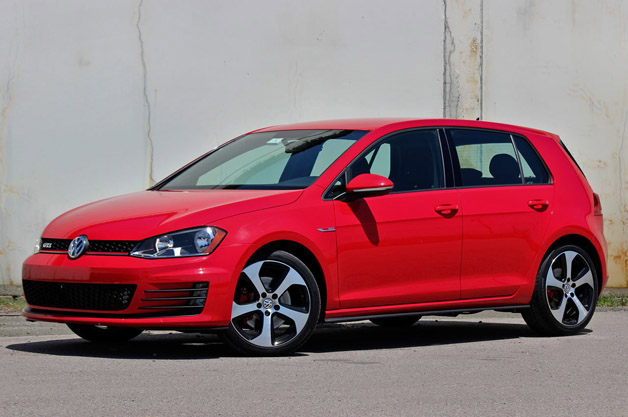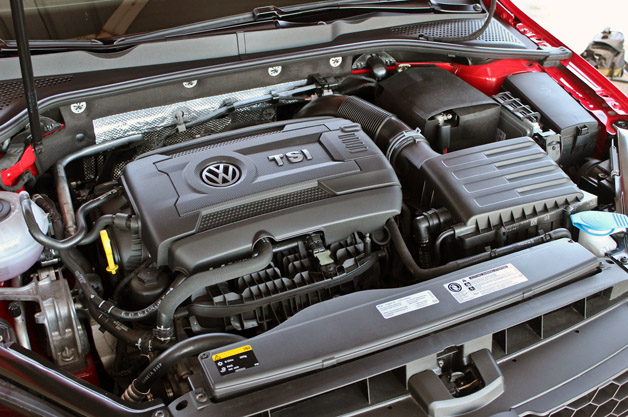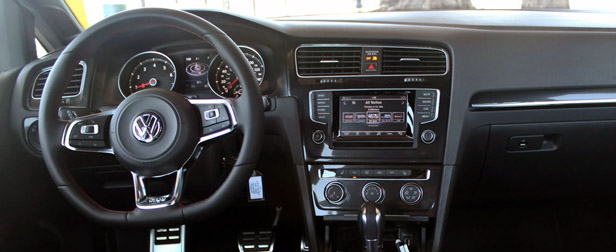
The whine of the turbocharger. The gentle whoosh of the
hatchback's hydraulic lift supports. The mechanical ratcheting and clack of the
parking brake. The growling exhaust note with that occasional gurgle.
The unmistakable sounds of the modern hot hatch are just one of the genre's delightful qualities. This class of car, beloved by enthusiasts for its amplitude of sensory stimulants, low curb weights, potent engines and superior handling, traces its lineage directly back to the MkI Volkswagen GTI, which debuted at the Frankfurt Motor Show back in 1975. Upon its unveiling, theGTI was a near-instant success, spawning its own subclass of vehicle – a basic, mass-market commuter vehicle with a high performance package – as well as a plethora of new hot hatch suitors from automakers like Ford, Peugeot, Renault and Fiat.
Since that day nearly 40 years ago, the GTI has won awards, fended off rivals, undergone numerous tweaks, nips, tucks, redesigns and refreshes, but rarely lost its way. The GTI has always, first and foremost, provided its owners with an entertaining, confident driving demeanor full of those wonderful sights, smells and, of course, sounds, all for an attainable price.
The unmistakable sounds of the modern hot hatch are just one of the genre's delightful qualities. This class of car, beloved by enthusiasts for its amplitude of sensory stimulants, low curb weights, potent engines and superior handling, traces its lineage directly back to the MkI Volkswagen GTI, which debuted at the Frankfurt Motor Show back in 1975. Upon its unveiling, theGTI was a near-instant success, spawning its own subclass of vehicle – a basic, mass-market commuter vehicle with a high performance package – as well as a plethora of new hot hatch suitors from automakers like Ford, Peugeot, Renault and Fiat.
Since that day nearly 40 years ago, the GTI has won awards, fended off rivals, undergone numerous tweaks, nips, tucks, redesigns and refreshes, but rarely lost its way. The GTI has always, first and foremost, provided its owners with an entertaining, confident driving demeanor full of those wonderful sights, smells and, of course, sounds, all for an attainable price.

We've been waiting a long time for our first crack at a US-spec model (it's been on sale over in Europe for some time now and we actually first drove an overseas-spec example over a year ago), but that day has finally arrived. Has it been worth the wait?
Up and over the towering hills outside Berkeley, CA and
along the dusty streets that create a patchwork of industrial complexes beside
the San Francisco Bay, our bright red GTI was a crimson blur as it tore over
the asphalt. Even with the air conditioning on full blast – outside, the
mercury had reached 96 degrees – the little hatch flew off the line and nimbly
tackled every corner with such competence and confidence that one could swear
the car was physically affixed to a set of tracks. The GTI has always been a
hoot to drive, but with new design and engineering tweaks for the seventh
generation, the car has reached a whole new level of playfulness.

Perhaps the biggest contributor to the new GTI's fun is a reduction in its curb weight. Coming in at 3,031 pounds, the MkVII is 82 pounds lighter than its predecessor. That's particularly laudable in light of the fact that it has become larger in nearly every dimension, with the savings coming mostly through the car's new lightweight MQB modular chassis and more compact engine.

The engine, called EA888, is technically new, but remains a classic 2.0-liter turbo. With this new powerplant, the GTI is capable of producing an additional ten horsepower versus its antecedent, topping out at 210 hp at 4,500 rpm. More importantly, it comes with a whopping increase in torque: from 207 pound-feet on the MkVI up to 258 lb-ft on the new generation. Volkswagen achieved these new power figures through a number of tweaks. These notably include employing the latest cam phasing system and upping the pressure of the direct-fuel-injection system to 2,900 psi.
Whether it's mated to its quick-shifting six-speed DSG
dual-clutch gearbox or more engaging six-speed manual, the 2.0T gets the GTI
gets up to speed in a hurry – 0-60 in about 6.5 seconds, according to VW –
while being more efficient than ever. When equipped with the six-speed manual,
it can achieve 25 miles per gallon in the city and 34 mpg on the highway,
substantial improvements over the MkVI's 21 mpg city and 31 mpg highway. When
equipped with the DSG, the fuel economy is 25 mpg in the city and 33 mpg on the
highway.

Power, though, has never been the main defining characteristic of the GTI. Sure, its moderately aggressive acceleration off the line is a good time, but where it has always shone is in its handling. With the MkVII, that continues to be the case in a very big way. The GTI's aforementioned new chassis is stiffer and lighter, with ten-percent more torsional rigidity. It has also been lowered 0.6 inches compared to the standard Golf and it employs a larger 24-millimeter anti-roll bar on the front suspension and a 20-millimeter unit in the back. But that's only part of the story here. Volkswagen has gone to great lengths to outdo itself when it comes to handling, with a number of new and improved technologies.
All 2015 GTI models come equipped with VW's latest
generation of XDS, the company's electronic riff on a conventional mechanical
limited-slip differential system. The technology, which works by acting on the
brake of inside front wheel in corners, helps negate understeer and enhance
traction. While no substitute for a mechanical LSD on the track, for the
street, XDS provides the right amount of intervention in corners. Additionally,
the GTI now comes with an ESC Sport function, which allows the driver to
dictate the level of traction control intervention, as well as the level of
stability control, in the event that experienced drivers desire more control
than the VW's electronics will otherwise allow.
The GTI employs a progressive electric power steering system, which offers just the right amount of weight and is super responsive. Spacing the teeth on the rack more tightly in the center, it now has a much lower steering ratio, allowing the driver to make use of different steering rates at various speeds and in varying driving conditions. Selectable drive modes (Normal, Sport and Individual) noticeably alter this electronic steering system's heft, as well as the engine's throttle response.
Opting for the late-availability Performance Package is the icing on this delicious little cake. Included in this upgrade suite is an electronically controlled, torque-sensing mechanical limited-slip differential, VAQ, that takes the place of the brake-based XDS system mentioned earlier. Monitoring data from each wheel sensor, the car is absurdly quick to react when it senses slippage, transferring torque to the opposite wheel with more traction. The Performance Package also nominally increases the car's power output by 10 horsepower and adds bigger brakes, all for a very reasonable-sounding $1,495.
The GTI employs a progressive electric power steering system, which offers just the right amount of weight and is super responsive. Spacing the teeth on the rack more tightly in the center, it now has a much lower steering ratio, allowing the driver to make use of different steering rates at various speeds and in varying driving conditions. Selectable drive modes (Normal, Sport and Individual) noticeably alter this electronic steering system's heft, as well as the engine's throttle response.
Opting for the late-availability Performance Package is the icing on this delicious little cake. Included in this upgrade suite is an electronically controlled, torque-sensing mechanical limited-slip differential, VAQ, that takes the place of the brake-based XDS system mentioned earlier. Monitoring data from each wheel sensor, the car is absurdly quick to react when it senses slippage, transferring torque to the opposite wheel with more traction. The Performance Package also nominally increases the car's power output by 10 horsepower and adds bigger brakes, all for a very reasonable-sounding $1,495.
Of course, specifying the Performance Package also gives
buyers the opportunity to pony up a further $800 for the latest version of
Volkswagen's Dynamic Chassis Control adaptive damping system, which improves
chassis dynamics by managing the suspension's rebound and compression rates
through electrically adjustable dampers. The system is also acted upon by the
GTI's driver-selectable system, meaning that the car's ride can also be
user-tailored to fit the situation at hand.
The GTI is perfectly capable without this package, by the way, but it allows the driver to push the car a good deal harder. All in all, the combination of weight reduction, the increase in power and the new handling technologies allow the GTI to maneuver around corners as crisply as an expert skier in fresh powder, with the payoff being a back end that's about as easy to safely bring around as we've experienced in a front-drive car. Indeed, on a winding, mountain road, one gets the impression that the GTI has already begun preparing you for the next turn before the current one is even over. It's a wonderful balance between a car that is so foolproof that it feels as if it could outdrive you itself (like a Nissan GT-R) and one that cedes all control to its operator (like an SRT Viper). Volkswagen found the middle ground that kept our pleasure synapses firing, yet our mind consistently at ease, even while taking turns a thousand feet up above the bay.
The GTI is perfectly capable without this package, by the way, but it allows the driver to push the car a good deal harder. All in all, the combination of weight reduction, the increase in power and the new handling technologies allow the GTI to maneuver around corners as crisply as an expert skier in fresh powder, with the payoff being a back end that's about as easy to safely bring around as we've experienced in a front-drive car. Indeed, on a winding, mountain road, one gets the impression that the GTI has already begun preparing you for the next turn before the current one is even over. It's a wonderful balance between a car that is so foolproof that it feels as if it could outdrive you itself (like a Nissan GT-R) and one that cedes all control to its operator (like an SRT Viper). Volkswagen found the middle ground that kept our pleasure synapses firing, yet our mind consistently at ease, even while taking turns a thousand feet up above the bay.
Changing gears, we arrive at something assuredly less
compelling to experience, but also entirely new for the GTI: Its looks. The
MkVII has achieved the rare designation of being a car that is instantly
recognizable yet is also very different. It's like running into an acquaintance
you haven't seen since high school, their overall appearance similar to what
you remember, but with welcome, conspicuous changes due to years of maturing.
The bodystyle, stance and many exterior cues on the new GTI are very similar to the previous generation. The most notable change is with its front fascia, which has angular new headlights and a slimmer grille. The car has grown in every direction but up, though its larger size is really only apparent to the keenest of observers. There are bold new 18-inch wheels, which make up our favorite part of the exterior. From most angles the GTI remains typically clean and understated, largely eschewing the bold aerodynamic visual aids often favored by its Japanese and American rivals. For some, that may be a missed opportunity, but it's pretty well par for the course for the GTI, which has always been reserved. If anything, the front end has a bit more going on in its lower extremities than before, with those contrasting black strakes making us a bit uneasy.
The bodystyle, stance and many exterior cues on the new GTI are very similar to the previous generation. The most notable change is with its front fascia, which has angular new headlights and a slimmer grille. The car has grown in every direction but up, though its larger size is really only apparent to the keenest of observers. There are bold new 18-inch wheels, which make up our favorite part of the exterior. From most angles the GTI remains typically clean and understated, largely eschewing the bold aerodynamic visual aids often favored by its Japanese and American rivals. For some, that may be a missed opportunity, but it's pretty well par for the course for the GTI, which has always been reserved. If anything, the front end has a bit more going on in its lower extremities than before, with those contrasting black strakes making us a bit uneasy.
Inside, we're happy to report that the GTI's signature
"Clark" plaid seating is still offered. We don't see why you'd ever
opt for it, but black leather is available, as well. Besides being delightfully
retro, the plaid seats are properly comfortable and supportive, offering a nice
amount of bolstering. Importantly, interior space has been improved in every
dimension, with shoulder space increased by 1.2 inches in the front and 1.1
inches in the back, and elbow room has been upped 0.9 inches and 0.8 inches,
respectively. Legroom in the back still isn't great, especially if the front
seats are pushed rearwards a bit. Fitting five adults inside is a stretch, but
it's not out of the question, particularly for shorter runs, and especially if
the car in question is the five-door model.
The controls have been moved around a bit to improve ergonomics. The new cabin has been designed to be more driver-centric, with the center stack angled more dramatically toward the operator's seat. Aesthetically, the GTI's interior is sporty, with red ambient lighting, illuminated door sills, a GTI-specific instrument cluster, sporty aluminum-look pedals, a variation on the GTI's legendary dimpled golf-ball shift knob, and a flat-bottomed steering wheel. We'd stop just short of calling the cabin "luxurious" or even "premium," but it still has hints of the finer things, including a plethora of soft-touch plastics and a high level of sound dampening which contributes to a surprisingly quiet ride.
The controls have been moved around a bit to improve ergonomics. The new cabin has been designed to be more driver-centric, with the center stack angled more dramatically toward the operator's seat. Aesthetically, the GTI's interior is sporty, with red ambient lighting, illuminated door sills, a GTI-specific instrument cluster, sporty aluminum-look pedals, a variation on the GTI's legendary dimpled golf-ball shift knob, and a flat-bottomed steering wheel. We'd stop just short of calling the cabin "luxurious" or even "premium," but it still has hints of the finer things, including a plethora of soft-touch plastics and a high level of sound dampening which contributes to a surprisingly quiet ride.
The GTI includes a new 5.8-inch touchscreen, which houses
its new infotainment system. In terms of its look and feel, it's among the
least-remarkable systems we've tested, employing plain graphics and a
thoroughly uninspired black background. But the system does as it's asked, and
it does so with minimal lag and frustration. Considering the bulk of
maddeningly sophisticated systems we've tested in the recent past, we don't
actually mind this sort of functional simplicity.
The GTI is truly better than ever. New technology, a new engine and new weight savings have made this hot hatch into something every auto enthusiast should try.
The car starts at $24,395, which represents an impressive $700 decrease from the MkVI (it's now assembled in Mexico, which helps trim costs). There are more options than ever with which to bloat the bottom line, but the GTI still remains a truly affordable performance buy. The fact that this car can be so much fun – and yet still be easily attainable – might be its best quality of all.
This hot hatch has changed a lot over the years, most of it for the better, but for now, the GTI continues to retain the basic formula that has kept us so enamored with its nameplate since that day it changed automotive history nearly four decades ago.
The GTI is truly better than ever. New technology, a new engine and new weight savings have made this hot hatch into something every auto enthusiast should try.
The car starts at $24,395, which represents an impressive $700 decrease from the MkVI (it's now assembled in Mexico, which helps trim costs). There are more options than ever with which to bloat the bottom line, but the GTI still remains a truly affordable performance buy. The fact that this car can be so much fun – and yet still be easily attainable – might be its best quality of all.
This hot hatch has changed a lot over the years, most of it for the better, but for now, the GTI continues to retain the basic formula that has kept us so enamored with its nameplate since that day it changed automotive history nearly four decades ago.
Image Credit: Copyright 2014 Michael Zak / AOL
source: autoblog
by Michael Zak
http://www.boscheuropean.com
No comments:
Post a Comment